Artists at Work: Gerard & Kelly
by Natilee Harren
Gerard & Kelly is a collaboration in art, writing, and dance between Brennan Gerard (b. 1978) and Ryan Kelly (b. 1979) begun in 2003. Through choreography, writing, sculptural objects, video, and multimedia installation, Gerard & Kelly’s practice has engaged topics such as collective and individual memory, time, the relationship between dance and visual art, gender and sexuality, queer subjectivity, and the figure of the couple. Gerard and Kelly earned MFAs from the Interdisciplinary Studio program at UCLA in 2013 and completed the Whitney Independent Study Program in 2010. Before their collaboration, Gerard studied theater and women’s, gender, and sexuality studies at Yale University, and Kelly was a dancer with the New York City Ballet. Gerard & Kelly has presented its work at or with the support of the Hammer Museum, Los Angeles Contemporary Exhibitions (LACE), University of California at Irvine, The Kitchen, CCS Bard Center for Curatorial Studies, Danspace Project, The Watermill Center, Park Avenue Armory, and the New York Performance Artists Collective, among other venues. In 2013, Gerard and Kelly organized Dancing with the Art World, a major symposium on the evolving relationship between dance and the visual arts, held at the Hammer Museum.
The following conversation took place in June 2014 behind the artists’ studio building in Lincoln Heights, over shrimp tacos and the sound of passing trains.
NATILEE HARREN: You’re about to launch a project for the Hammer Museum’s “Made in L.A.” biennial. I’d like to start by asking you about that project and how it builds off of and moves your earlier practice forward.
RYAN KELLY: The work that we’re showing at the Hammer biennial [Reusable Parts/Endless Love and Kiss Solo]—which was made over a few years, from 2011 up until the beginning of 2013—was driven by a question for us, which was: How are representations of the couple produced, circulated, and consumed? That question emerged from an encounter with another artwork, Tino Sehgal’s Kiss, when it was exhibited in 2010 at the Guggenheim. We were struck by a lot of diverse feelings when looking at that performance happening in the museum rotunda: excitement, pleasure, a “where are the objects?” kind of feeling. Immediately, we were aware of two things: that we were looking at a man and a woman kissing and that we were looking at a strictly choreographed dance.
We returned a number of times and ultimately found an audition call. I’m not even sure we knew what we were doing, but we decided to notate these movements that we were seeing by speaking them descriptively into our iPhones, largely due to the fact that there was no other way to record them. You couldn’t take a video and you couldn’t take a photograph because the security guards would come down on you.
NH: You simply couldn’t take in the performance the way we often see people do in museums, by taking pictures, taking selfies. Your first step was to embody the piece by translating it into your own language, into a score.
BRENNAN GERARD: I think it was a process of reading. We read the work as choreography, but it doesn’t present itself as choreography. It presents itself as almost spontaneous, with some images—
NH: A series of vignettes?
BG: Yeah. But then we realized that it was rigorously choreographed on a 12-minute loop, so we started to read the choreography. We were also reading it as a text that was heteronormative, describing romance and referencing images of the couple. We couldn’t document that by video or photo, so the only way we could document our reading of it was to transcribe the movements as they were happening in front of us, in our own words.
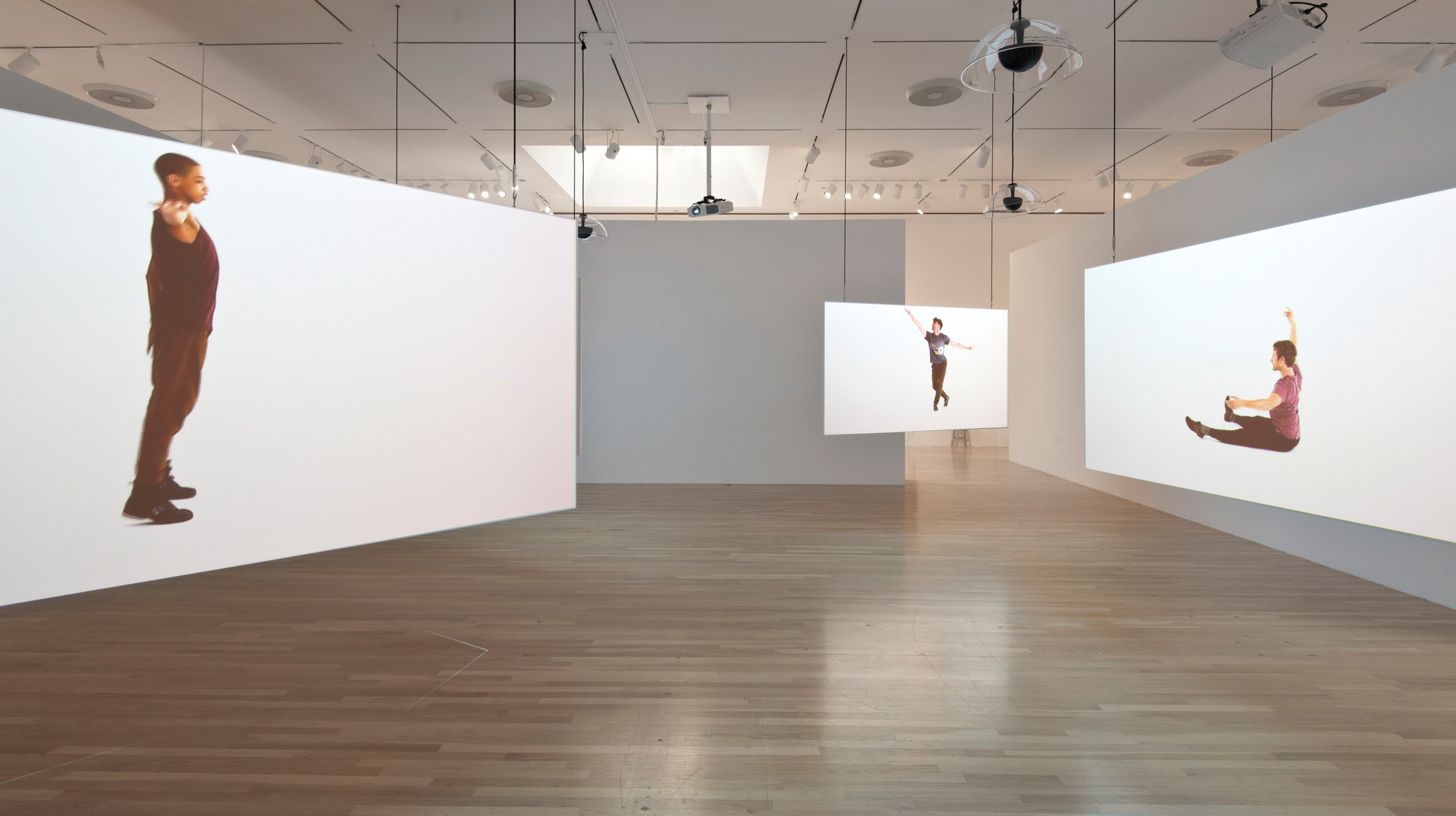
Gerard & Kelly. Kiss Solo, 2012. Made in L.A. 2014. Installation view at the Hammer Museum, Los Angeles. June 15-September 7, 2014. Photography by Brian Forrest.
RK: We weren’t even aware that we were making an art project or creating a score. That didn’t come until many months later, after some productive studio visits. At some point, our reading of Seghal’s choreography became the source for more writing and rewriting and rewriting again. This came to fruition in two different ways that emerged from our encounter with that piece—one being a projected image and sound installation called Kiss Solo and the other, a performance called Reusable Parts/Endless Love. They do overlap quite a bit, and many of the performers in Reusable Parts/Endless Love also appear in Kiss Solo.1 In both, they are given the task to respeak a verbal description of Sehgal’s Kiss. As they’re doing it for the first time, their own slips, slurs, and mistakes are captured. Then that recording of their own voice is played back and they use it as a score for moving. A description becomes a direction. The performers literalize each thing they hear, occupying both the male and female parts with their own bodies, transposing the movements of the couple to the individual. Having that task performed across an endlessly accumulating group of people helps us get around that first question of how a representation of intimacy is produced and toward a kind of unscripted situation.
NH: This leads me to this question of how the score functions as a kind of diagram within your practice and whether this might allow us some new language to talk about your work. In previous interviews, you’ve often brought up this idea of an expanded sense of queerness—queer temporality, queer space, and so forth—but, as I was looking back at your projects, I was actually thinking about this idea of trans. You use transgender performers, and I feel like trans is a term that helps me understand the way that a score can operate within your practice as an engine for transferal, for transitoriness, for translation; this idea of not just hybridizing or expanding things, but of moving from one body to the next or from one person’s language to the next.
BG: That’s very interesting to me, because we were thinking a lot with the idea of inter-—in between. Especially in our last work, Timelining, intersubjectivity became a really important idea. Trans suggests activity—it means across, not between—so a “between” could be stable, whereas “across” implies that it’s always a movement, that there’s motion there.
RK: I also think that within trans is an idea of transmission, particularly in how we think about the score. Earlier today, we were beginning to teach the score of Reusable Parts/Endless Love to Nick Duran and Julie Tolentino, who will perform it at the Hammer. So there are two different points of transmission: There’s the score, which is written down on one page, but its verbal transmission introduces all this qualitative and historical information that is not quantified in the six operations of the score as it is written on paper. Anyone can pick up the written score, but the work is only partially complete without that historical information that needs to be transmitted from generation to generation, from body to body, from subjectivity to subjectivity. This becomes extremely important when we think about how museums are changing—how a museum’s collection and activities need to change. That stuff that can never be captured in a search or quarried for big data—the things we’ll be really concerned about in five years.
BG: Even in psychoanalysis, you can read everything, but you still have to go through analysis to become an analyst. You have to take the time to go through it. Reusable Parts/Endless Love is not as long of a process, of course, but there is something about that transmission process, of privileging the time and experience of learning something, that really can’t be codified.2 That’s not to say people other than us can’t repeat it—after we’ve gone through this process with Julie and Nick, they could transfer it to other people—but there’s a process of transmission that is very specific.
NH: This is something that performers, dancers, and artists of older generations are newly and urgently dealing with, in terms of sorting through the legacy of their practices. These are questions that you’re already thinking about—thinking of historical legacy, of transmission, of the life of this artwork?
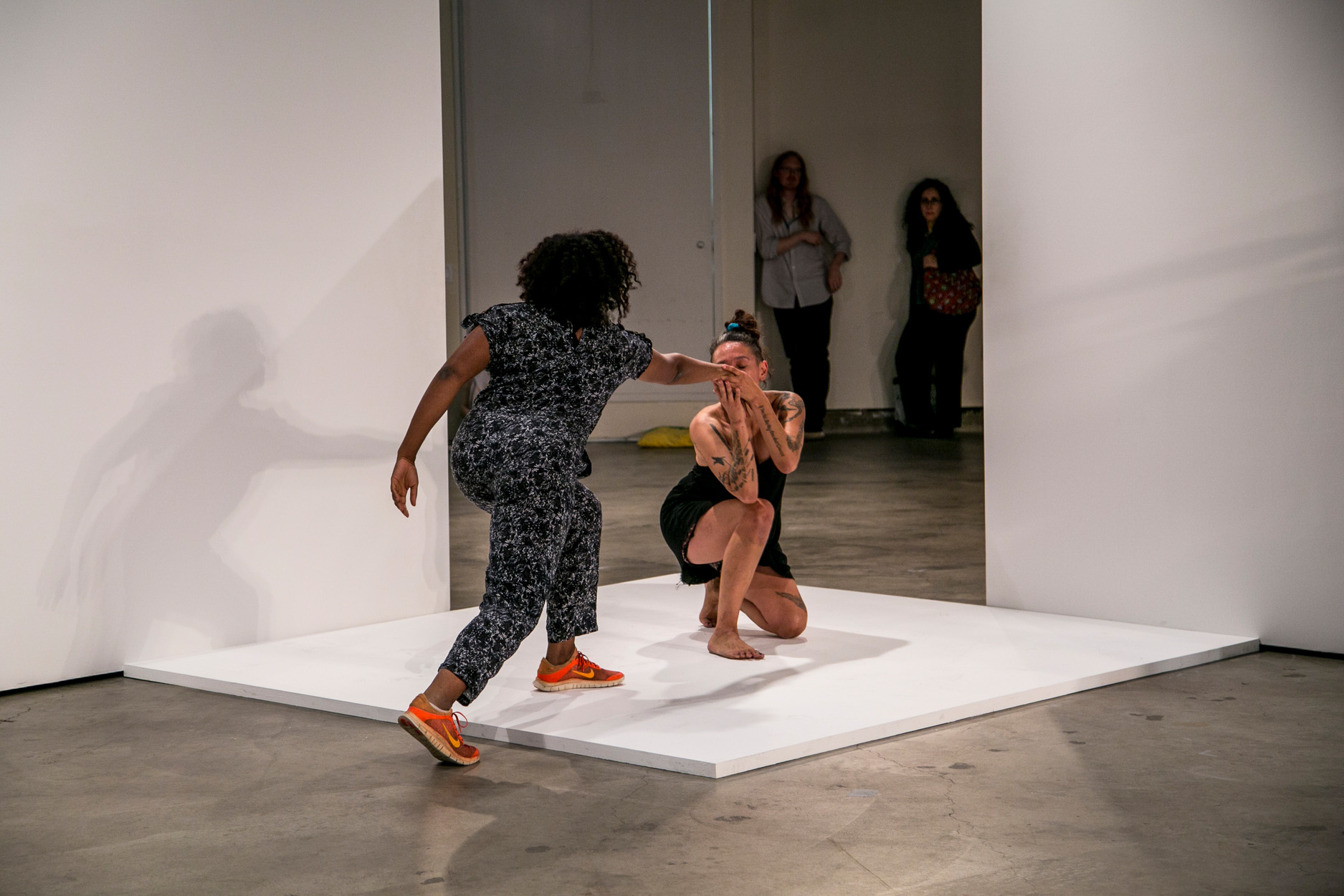
Gerard & Kelly. Reusable Parts/Endless Love, 2011/2014. Made in L.A. 2014. Performance at the Hammer Museum, Los Angeles. June 20, 2014. Photography by Barbara Katz.
BG: Definitely. I can definitely see older artists thinking about these processes, but there’s also something about our specific historical moment, where information and answers are readily available. If we want to find something, we can go find it. But somehow, we’re still not getting what we really want. You can get the score, but you don’t necessarily get the work. The work requires a different kind of experience that people are hungry for. We live in a world in which our desire for knowledge is immediately satisfied, but the desire for transformation is not. Part of the work is not just the performance that the spectator sees, but hopefully also the desire to want to participate in the process of the transmission.
The first performance of Reusable Parts/Endless Love started with our description of Sehgal’s Kiss, and through 72 minutes and six operations, it arrived at a new 12-minute score. When we start the first of five cycles of the score that we’ll do at the Hammer, we’re starting from that new score generated by the last performance of Reusable Parts/Endless Love.
NH: So multiple bodies have already translated it.
RK: The score has already been translated by a different group of people at a different moment in time, during that first performance. Every time the work is shown, the new performers start where the previous group of performers left off. In this way, a group of voices carries across time, and this transmission is structured by the work itself. That’s why it’s called “endless.” It will go on for as long as people remake it. To me, that’s a different kind of pleasure—the pleasure of not knowing, the pleasure of not being able to have the same experience.
BG: It’s the pleasure of not being the standard. No one can actually occupy the standard.
NH: As a straight woman who is in a monogamous, married relationship and has a child, I have to admit that my relationship to those very normative categories of identity feels queer in some ways. Even the experience of being pregnant is one of the most self-othering experiences you can have, and I think that’s why our culture tries so hard to uphold certain institutions and identities as standard, because they’re difficult to maintain, even for people who seem to comfortably occupy them.
BG: Reusable Parts itself is kind of recursive, and I hope that one of the things that it is demonstrating is something about how gender and sexuality work. One, that they’re separate, and two, that none of us will ever achieve the standard. It’s also trying to chart that instability in the moment of the performance. We’re not even starting with the score from the recording that we made at the Guggenheim. We’re starting after it’s already been through something else.
NH: It really radically transforms our understanding of what a score is. The score here is not a kind of blueprint to which the performance always returns—it becomes an inaugural gesture that produces performances that continuously propel forward through a situation that is always of the present pushing toward the future. The score is rewritten or respoken and then reperformed for each and every now.
RK: Absolutely.
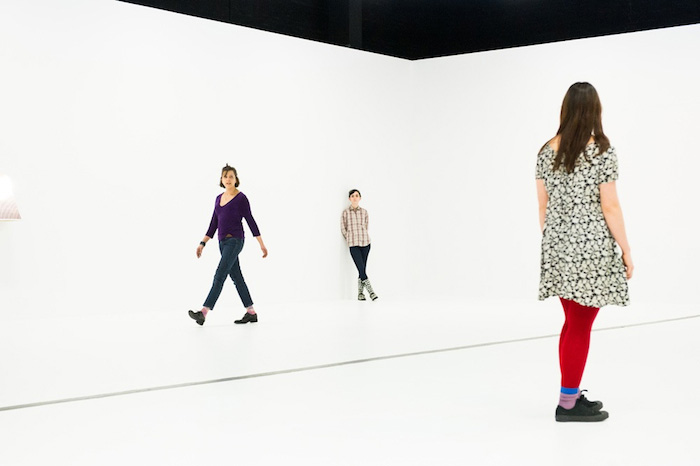
Gerard & Kelly, Timelining, 2014. Performance, duration variable. Performance view, The Kitchen, New York, NY, March 2014. Pictured: Lissy Vomáčka and Anna Vomáčka. Photo: Elisabeth Bernstein.
NH: Timelining, the project that you just did at The Kitchen, obviously had very much to do with time and chronology and how partnerships are structured by time. Have you thought about how Reusable Parts/Endless Love relates to this question of time?
BG: Actually, what’s exciting about the opportunity to do this at the Hammer is that it’s the first time that we’re going to be able to do it on multiple loops. With the first iteration of this work, we could only do one cycle—it was presented in an event structure, with a scheduled start time. At the Hammer, as with Timelining at The Kitchen, the work will unfold within the temporality of an exhibition, which is structured by encounters rather than events.
RK: We’re really into the idea of creating a container with the score—you fill it once and get one effect, but if you fill it again, you might get a different effect. The score is structured, zero minutes to 12 minutes, but within it, there’s a different kind of time—the time it takes for the performer to respond to his or her own voice. Since the first presentation [at Danspace Project at St. Mark’s Church in New York] was within the context of a dance/theater framework, we were very actively resisting the organization of the work around any kind of narrative or plot development. Those elements are still there, sublimated, but I think that using a strict organization of time—six operations, each 12 minutes long, repeat—was a way of largely getting away from any kind of dramatic or narrative development as the organizing principle of the work.
NH: This brings up a question that you have touched upon in your writing about dance in the art world: the question of economics and the way in which doing a one-off performance, which is very typical for dance, becomes a question of labor in a much more pressing way when you’re entering an exhibition space and the show is on for weeks at a time. Is this something that you’ve had to deal with more, presenting your work in a kind of exhibition-based model?
RK: Totally. We’re still thinking it through, in terms of the kinds of institutions or organizations that need to operate now in order to ensure that this kind of work is adequately compensated. Do we reform the museum’s practices or do we create new organizations—or both? Certainly, the logic of postwar art—that the artist pays for a work’s production and will later be compensated through its eventual sale—doesn’t work with performers, whose labor is happening now and who will not benefit from the eventual sale of the work. We need a new production model, but coming up with what that looks like is actually really complicated. Everyone’s working hard to make everything as fair as possible, but there is no model for it. It’s, like, who does this? And what standards are they compensated by?
NH: It does bother me that people in the art world act as if there aren’t already functional models for this. There’s a whole history of performers unionizing themselves, but it seems like museums sometimes pretend that it’s just not possible.
RK: Now it’s already amazing that anybody gets paid at all to participate in a show. Museums generally don’t pay artists, but if the work can never be shown, only remade—which is not a condition exclusively of a performance—then we need another standard for compensating the artists, as well as the performers who might be fabricating or producing the work.
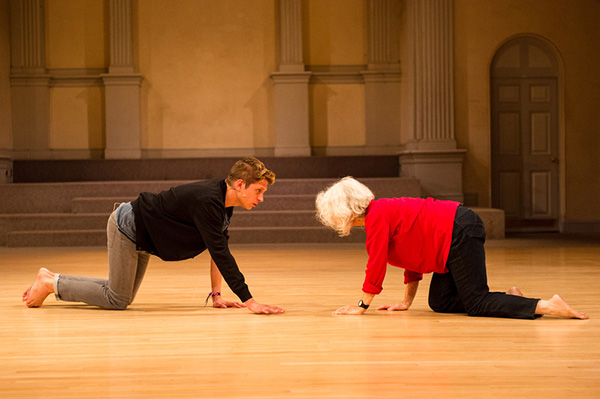
Brennan Gerard (left) performing with Simone Forti in That Fish is Broke at Danspace Project, St. Mark’s Church, New York, NY, 2012. Photo: Ian Douglas.
NH: That leads me to think of the post-minimalist moment when artists, as a political gesture, moved toward a process-oriented model so that their work could not be expropriated from them. The kind of revolution they hoped to instigate with that practice may be coming to fruition only now. There’s much that resonates between your practice and this moment in the ’60s, not just through some of the artists that you’ve worked with, such as Simone Forti, but also in your search for other models of time. George Kubler’s The Shape of Time was published in 1962, and it was that moment of the ’60s when artists began to try to think about different models of time. Maybe this is a problem we haven’t figured out yet.
RK: I think that the work of the 1960s, and specifically this resistance to expropriation of one’s labor, is an important thing to hold on to. But at the same time, I think that in our era, the logic of the museum as a collecting institution—as opposed to the theater as a presenting institution—is really important. The idea that the museum can take an artwork out of circulation forever is subversive, particularly in a moment of economic hegemony in which everything can be traded and speculated upon. What wouldn’t have made sense to those artists in the ’60s was that their ally was the museum collection. Museums should form collections for ephemeral and performance work, and what artists need to do in their work is think about how they’re going to interrogate what museums think a collection is and what they think their obligations to that collection are. That’s where things get interesting.
NH: And this can bring us back to Reusable Parts/Endless Love and how that work relates to this dialectic that we’ve been sketching out: the artwork as this infinitely exchangeable thing versus the artwork as an inert material object that exists in space. The way that you’ve engaged Tino Sehgal’s work has propelled it forward and allowed it to transmutate and brought some funkiness into it that it didn’t have.
RK: The space does start to smell. No, seriously, it’s been reported—kind of like a gymnasium.
NH: [laughs] That’s how you know it’s a good piece. It’s real! That’s what it means to bring bodies into the space of a museum.
RK: It’s true; it’s not all pretty.
NH: I do want to ask you about your engagement with the production of objects—of images, of sculptural forms—and the ways in which even your dancerly pieces have engaged with props, sets, and so forth. Can you talk about your engagement with objects?
RK: In the objects, there’s a desire to want to find another way of expressing, of working, of registering, like, “this piece happened now”—though the pieces that were part of the show at The Kitchen were made of Braille and polished copper, and they actually are changing in time. Because of the Braille, they attracted a lot of touch and they will all oxidize differently, based on how people are touching the work. They stop time in its tracks in a way, registering the “now,” but they’re also far less stable than it first appeared. They continue to be acted upon and continue to change.
BG: Our objects always come from projects. Reusable Parts and Kiss Solo come from the same project, but they are independent works. They may iterate in different forms, but I think that most importantly, objects and images can create in the viewer, and the maker, a desire to know more.
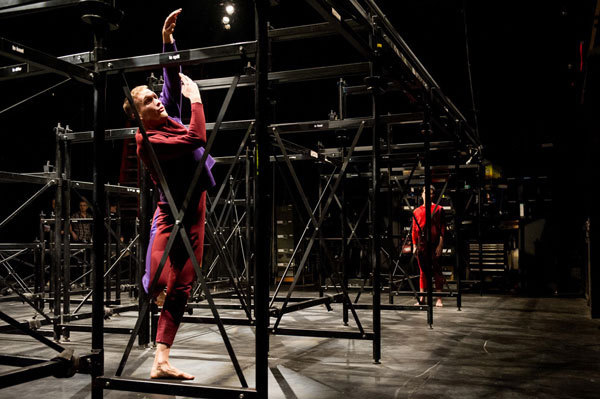
Gerard & Kelly, Verb Dance, 2014. Performance and 108 magnets, duration variable. Performance view, The Kitchen, New York, NY. Photo: Ian Douglas.
NH: That reminds me of something that you said before, Ryan, in another interview: “I think dance could be useful.” The way that you use the apparatuses of performance—like the steel risers that you used in Verb Dance at The Kitchen, a dance performance that appropriated Richard Serra’s Verb List [1967–68] as a score—are a way of rereading sculptural history through the lens of choreography.3 What I get from your practice is that you’re saying that now we’re at a moment in history in which the work is situated in the body rather than in an object—it’s about bodies meeting in space.
RK: I am not against objects, nor do I presume that objects are more likely to alienate the work of their producers than nonobjects. Everyone alive today and subject to the virtual world of social networks senses that our performances, affects, ideas, relationships, and appearances are constantly alienated from us, as well. In 2014, we can’t just say that objects are bad and nonobjects are good—it just doesn’t work. In fact, if we want to respond to the economic conditions of today, we should probably be making sculptures like Richard Serra’s that are big and bulky and cost a lot of money to move and don’t even photograph well because you can’t fit them in the frame. But that’s akin to nonparticipation because that’s saying that the only answer to the problems of now is to travel back in time.
NH: Have you ever thought about your work in terms of an institutional critique of and through the body, where you’re dealing with the institutions of marriage, of gender, of time, or the family?
RK: I would say yes, in the way you used that term. I don’t know if we’ve ever discussed our work in relationship to that art historical moment, but it does seem that the term institutional critique is changing, absolutely. I think that asking questions of precisely those institutions you list is what drives our work. These are the institutions—of marriage and the family, which have so much to do with what’s going on in culture right now and in the modern gay rights movement—that need to not necessarily be negated but definitely reworked.
NH: Absolutely. I think it’s a problem that’s felt by our generation, no matter how you identify personally. I think it relates to this general feeling of precarity on all fronts—that there are movements toward a reconsolidation of these institutions, and at the same time, there is a move away from them.
RK: I would say that the reconsolidation of those institutions is a way of responding to the problems of now without actually pushing the discourse forward. Maybe that’s what some of us have to do to survive, but there must be other solutions. There have to be some people who will strike out to find new solutions, or else we’ll start becoming deeply recursive in a way that is frightening. Already, there’s an understanding that this is happening because of a systemic defunding of the public sphere. Acknowledging that this is the effect of 30-odd years of neoliberalism in action is actually a first step to reworking those institutions. The problem with the gay rights movement is that it’s not interested in interrogating that; it’s not interested in seeing the relationship between gay marriage and neoliberalism. What should be really troubling to queers—people who have spent their lives in the precarious parts of culture—is that the national political conversation has not been about how everyone can be assured of social security and unemployment insurance in a time of chronic unemployment. That, I think, is the trouble of the gay rights movement right now—it’s largely interested in gaining access to the institutions that already exist, rather than reworking, rethinking, and looking for what institutions need to be built for everyone.
NH: These are also the stakes of Kiss Solo and Reusable Parts/Endless Love. Both works break open the dyad of the heteronormative couple for reworking and rethinking. Reusable Parts/Endless Love, in particular, has a self-reflexive operation of reworking and rethinking built into its very structure.
RK: One of the big reworkings we’ve done of Reusable Parts was that when we first did it, the cast was composed of people who identified as trans and gender-queer people. In Kiss Solo, that shifted, and now even more so with Reusable Parts—now women and straight people are part of it, too. I think I personally realized that many of my straight, unmarried girlfriends who are in their mid-30s are experiencing a similar kind of shame that many queer people feel. That they are failing at what has become thought of as the only institution to provide safety, security, and legibility—marriage. Even with straight people, not everyone is going to get married. It’s just not going to happen. We can’t rely on marriage or family as the only means by which we maintain the continuation of culture and the well-being of our society. Now, I don’t think Reusable Parts is providing an answer to this, but maybe it’s instigating ways of thinking so that we can begin to build those new institutions.